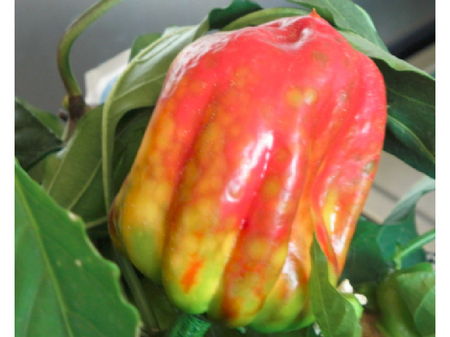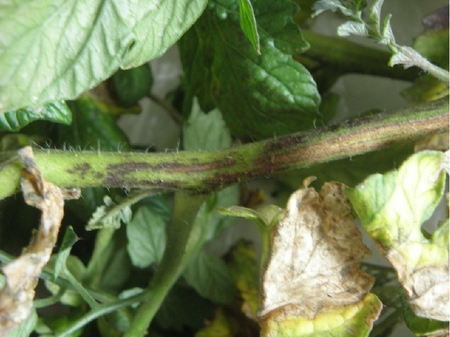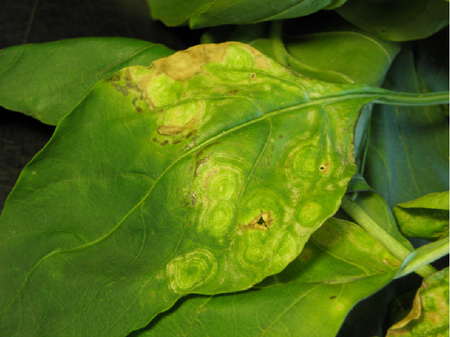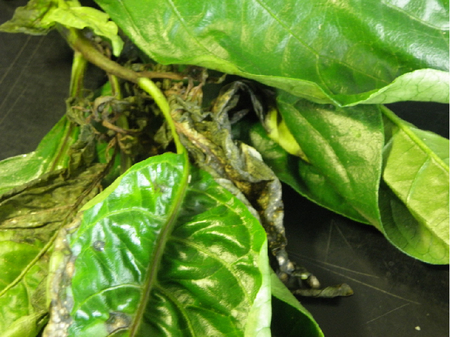Tomato spotted wilt virus
Tomato spotted wilt virus, TSWV
Profile
Tomato spotted wilt virus (TSWV) has a very broad host plant range. Worldwide, the virus still causes major economic damage, as it can lead to high production losses in both vegetable crops and ornamentals. The main symptoms that occur after infection include brown rings and discoloration of fruits, leaves and stems.
Damage symptoms
As with infections with other virus species, tomato bronze spot virus can cause upsetting, deformation, necrosis, and chlorosis on various parts of the plant. A relatively typical symptom of TSWV infections on many host plants is chlorotic or brown rings, often arranged concentrically. These ring markings can occur on leaves, fruits, and stems.
Especially on tomatoes, brown discoloration ("bronze spots") or black streaks often occur on leaves, fruits, and stems. Shoot tips may die (often seen in peppers and eggplant), resulting in plant death in young plants and increased side shoot formation in older plants.
The discoloration and deformation of the fruits caused by the virus make them unmarketable. Depending on the plant species and cultivar and the developmental state of the plant, the symptom expression may vary.






Propagation and transmission
Tomato bronze spot virus is transmitted by animal vectors (thrips), but also mechanically (e.g., cultivation work). California flower thrips(Frankliniella occidentalis) is most important in spread, although other thrips species, such as tobacco thrips(Thrips tabaci) and T. fusca, can also transmit the virus.
Virus acquisition is by sucking, with only larval stages L1 and L2 able to ingest the virus, and a sucking period (acquisition time) of about 30 minutes is required. The incubation period (time before the thrips can pass on the virus) is between 3 and 10 days, with maximum infectivity not reached until 22 to 30 days after virus ingestion. An infected thrips can transmit the virus throughout its life. Infection of new plants occurs only through adult thrips. Here, too, a sucking time of about 15 minutes is necessary. There is no transmission of the virus to offspring.
According to the EPPO, TSWV is not considered seed transmissible.
Furthermore, the virus is spread via irrigation systems, recirculating nutrient solutions, infected plant residues in the substrate, weeds, or by growing through in compost. Infected young plants or cuttings are also considered to be another route of spread.
Prevention and control
The virus particles of TSWV are found in all plant parts of an infected plant. They can remain infectious in the plant sap for about five hours and can be inactivated by heating at 45 °C for 10 minutes.
If plants are already infected with viruses, no curative measures are possible. Therefore, preventive measures are important to avoid getting the virus into the crops and spreading it in the stands. These include:
- careful control of the crops for thrips and their control
- strict adherence to all hygiene measures in all cultivation activities
- spatial separation of different crops or varieties
- the control of weeds in/around foil tunnels and glass houses
- the purchase of healthy young plants from safe sources and
- the removal of symptomatic plants from the stands.
Since other viruses also cause similar symptoms, testing in a diagnostic laboratory is necessary to confirm infection with TSWV. We detect TSWV and other tospoviruses by molecular biology. An analysis usually takes two working days.
Last updated: 13.09.2023
automatically translated